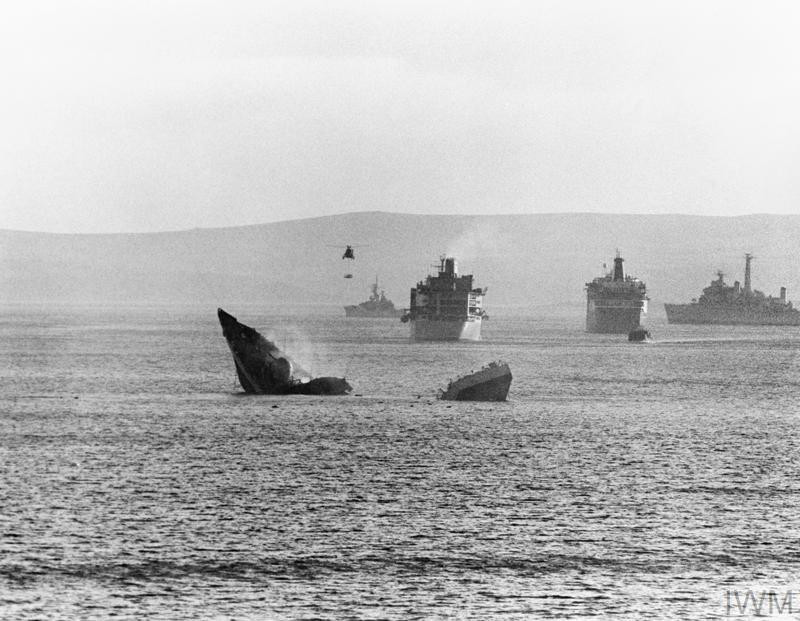The situation was far from secure for the British task group in the Falkland Islands on the morning of 24 May 1982, although the arrival of the Bristol Group of ships in the Total Exclusion Zone was a welcome development, particularly as both Type 82 destroyer HMS Bristol and Type 42 destroyer HMS Cardiff were specialist air defence ships.
The need for such support was very obvious to anyone looking out over San Carlos Water on that Monday.
Type 21 frigate HMS Antelope, wrecked by an Argentine bomb which detonated the previous afternoon while a two-man team of Royal Engineers attempted to defuse it, had been burning through the night, the blaze punctuated by occasional explosions.
It was clearly a matter of time before the ship succumbed to the damage, and one final explosion broke her back causing her to sink, her bows and stern forming a V as she slipped below the surface.
But there was little time to contemplate her fate as Argentine jets roared in for another day of attacks – though the pilots took a beating on this occasion.
First into the fray were four Daggers which flew in over Pebble Island, to the north-west of San Carlos Water, but Type 22 frigate HMS Broadsword had tracked them and vectored in a pair of Sea Harriers from 800 Naval Air Squadron, which brought down three of the Daggers with Sidewinder missiles.
Simultaneously, a group of Daggers and Skyhawks approached San Carlos Water from the south, and these aircraft did some damage.
Landing Ships Logistic RFA Sir Galahad and RFA Sir Lancelot were both struck by bombs which failed to explode, and a third bomb ricocheted off the hull of RFA Sir Bedivere, smashing through her crane before splashing into the sea and exploding in deep water.
Three Skyhawks from this attack were hit by a hail of anti-aircraft fire from the ships and shore, and one of the jets crashed into the sea in King George Bay on the west coast of West Falkland.
The bomb in Sir Galahad had entered her hull on the port side, smashed through several compartments wrecking a bulkhead en route, and ended up in the battery charging room in a tangle of metal and smashed containers of acid.
The Sir Lancelot bomb came to rest trapped beneath the steps of a companion ladder below the officers’ accommodation, nose-up.
What was more worrying for the task group commanders was the fact that the aircraft had been aiming for the amphibious ships – up to that point most of the targets had been escort warships, and a successful switch to supply vessels and troop carriers could make Operation Corporate that much more difficult.
And events the following day were to reinforce those fears.
Today’s image from the Imperial War Museum collection shows the last moments of Type 21 frigate HMS Antelope in San Carlos Water on 24 May 1982 (© IWM FKD 192), ).
* These posts can only give a brief sense of what was a complex and fast-moving situation 40 years ago, and cannot cover the involvement of every ship, squadron and unit in detail – for a much more comprehensive account see the Falklands section of naval-history.net at https://www.naval-history.net/NAVAL1982FALKLANDS.htm
The Royal Naval Association is the biggest collective group of Royal Naval veterans and serving personnel, with more than 270 branches in the UK and overseas.
The RNA provides those with a link to the Royal Navy access to a life-long community of like-minded and supportive individuals.
Our community provides companionship, resilience, comradeship and unity to anyone and everyone with a Naval story, supporting them through life's highs and lows.
Membership is now free (please note, some branches may charge a small annual subscription, payable locally on their request) – see https://royal-naval-association.co.uk/join-us/ for details of how to join.
